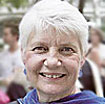Commentary on Isaiah 2:1-5
The First Readings for Advent, Year A, provide particularly rich visual gifts.
On all four Sundays these readings come from the book of Isaiah, and each reading is filled with visual images that could shape our preaching. Even if you don’t follow the lectionary these texts from Isaiah are still worth considering.
You probably know that I borrowed this title from Isaiah 2 that begins: “The word that Isaiah, son of Amoz, saw concerning Judah and Jerusalem.” We don’t talk that way. We would say, “The word that Isaiah, son of Amoz heard…”
What does it mean to see a word? I doubt that this was an early reference to texting or tweeting! I encourage you to consider preaching on the Isaiah texts through the season of Advent. Help people see the words of Isaiah. Some may consider projecting visual images on the screen.
If you’ve sworn never to put a screen in the sanctuary, consider a bulletin cover with a picture of each Isaiah text. Or do what we often do for children’s sermons — set an object in the middle of the aisle or in front of the communion table or in the narthex. What’s this plow doing here? (Isaiah 2) Who left this stump in the narthex? (Isaiah 11) Is that supposed to be a blue river flowing up the center aisle? (Isaiah 35) Who put the baby crib in front of the altar? (Isaiah 7)
Several years ago I was part of a worship planning team for a Presbyterian musicians’ conference. The opening service focused on the text from Joshua 4 where twelve stones are carried from the Jordan and set up at Gilgal. When people arrived for that service twelve huge boulders were piled in front of the church doors. As the week went on, people added stones they found: two stones that looked like footprints, a stone painted with a rainbow, and a stone the children gave me, carved with the word “REMEMBER.” Images stay with people — we can help them see the words of Isaiah this Advent.
First Sunday of Advent Isaiah 2:1-5
“The word that Isaiah, son of Amoz, saw concerning Judah and Jerusalem.” In chapter 1 Isaiah graphically laid out what he had seen: violence, bribery, unfaithfulness, desolation, trampling on the poor. There are brief interruptions as God calls for repentance and offers glimpses of hope, but they are drowned out by these pictures of violence and rebellion.
Then Chapter 2 opens as though Isaiah is starting all over again — or God is. What Isaiah sees is not taking place now, but “in the days to come.” People of every nation will stream to Mt. Zion, including those who were enemies of Israel and Judah. God’s instruction will go forth from Jerusalem; God will judge between the nations. The people will be transformed by this teaching. Can you see it?
they shall beat their swords into plowshares,
and their spears into pruning hooks;
nation shall not lift up sword against nation,
neither shall they learn war anymore.
Who can believe that? Isaiah’s words are carved into the wall across from the United Nations building. Who believes these words across the street in the General Assembly as they debate sanctions against Iran, as they wring their hands over 100,000 killed in Syria, and chastise the United States for inhumane treatment of prisoners at Guantanamo?
Like almost all the images we will see during this Advent season, Isaiah’s picture of swords turned to plowshares seems absurd. Maybe, Isaiah’s vision will be true in a far-off time, but for now, there’s nothing we can do but pray, “God of Peace, bring an end to the war in Syria. Lord, in your mercy, HEAR OUR PRAYER.”
We need to remind people that Isaiah was a realist. His pictures in Chapter 1 are as graphic as the evening news:
Your country lies desolate,
your cities are burned with fire…Benghazi
And daughter Zion is left like a booth in a vineyard,
like a shelter in a cucumber field, like a besieged city. Aleppo
Everyone loves a bribe
and runs after gifts. Congress
They do not defend the orphan,
and the widow’s cause does not come before them. The Sequester
Isaiah isn’t naïve. He is not a Pollyanna prophet. This vision of weapons of war turned into agricultural tools, images of death-dealing turned into food-producing is a promise for “the days to come.” But biblical visions in both testaments come to us from the future, longing to shape the days in which we are living.
What can we help people see?
- Can you see Christian and Muslim women all dressed in white? They were lying on their bellies near the main highway in Monrovia, Liberia, where everyone could see them. It was embarrassing to President Charles Taylor. They protested until he finally agreed to attend peace talks in Ghana. When the talks faltered, the women came to Ghana. Can you see them? They linked arms around the government building until the talks started up again. The tragic civil war in Liberia finally came to an end. Can you see the women dancing in the streets?
- Can you see the rice paddies, green and lush, stretching as far as eye can see in Cambodia? More than a dozen programs are ridding the country of land mines and providing survivor assistance to Cambodian people. The number of men, women, and children killed or injured each year by mines has fallen from a high of 4,320 in 1996 to 286 in 2010. Can you see the farmers working in the field?
- Can you see the children carrying signs near the Capital? “PROTECT CHILDREN, NOT GUNS.” Marion Wright Edelman and The Children’s Defense Fund refuse to be quiet about gun violence. They never give up. Against all the evidence, they believe weapons can be turned into plowshares or simply turned in at the local police station. Maybe children in your Sunday School classes can make some signs.
During these weeks of Advent, we’re invited to sing the Isaiah texts to the familiar melody of “O Come, O Come, Immanuel.” Each Sunday, a verse will be added until we sing all four stanzas on December 22, recalling image that have marked the Advent journey this year.
O come, O come, Immanuel
And bless each place your people dwell.
Melt ev’ry weapon crafted for war,
Bring peace upon the earth forever more.
Rejoice, rejoice! Take heart and do not fear,
God’s chosen one, Immanuel, draws near.


December 1, 2013